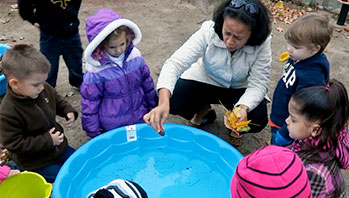- camera or cell phone with video camera
- clipboard for each pair
- markers
- pictures of houses and buildings with visible obvious shapes
- set of shape cards for each pair (square, triangle, circle, rectangle)
- circle
- rectangle
- roof
- square
- triangle
- wall
MA Standards:
Speaking and Listening/SL.PK.MA.1 Participate in collaborative conversations with diverse partners during daily routines and play.
Mathematics/Geometry/PK.G.MA.2 Identify various two-dimensional shapes using appropriate language.
MA Draft STE Standards:
Physical Sciences/Matter and Its Interactions: Structure and Properties of Matter/PS1.A Describe, compare, sort and classify objects based on observable physical characteristics, uses, and whether it is manufactured as part of their classroom play and investigations of the natural and human-made world.
Head Start Outcomes:
Logic and Reasoning/Reasoning and Problem Solving Classifies, compares, and contrasts objects, events, and experiences.
Science Knowledge/Scientific Skills and Method Observes and discusses common properties, differences, and comparisons among objects.
PreK Learning Guidelines:
Mathematics/Shapes and Spatial Sense 10 Investigate and identify materials of various shapes, using appropriate language.
Explore Together (outdoors): Building Shapes

© Commonwealth of Massachusetts, Department of Early Education and Care. All rights reserved.
STEM Key Concepts: How you design and build a structure helps determine how strong it will be; Different materials are useful for making different structures and different parts of structures
ELA Focus Skills: Comparing and Contrasting, Listening and Speaking, Vocabulary
Educator Prep: Make large shape cards for display: square, triangle, circle, rectangle. Prepare a display of pictures of houses with obvious shapes (square windows, rectangular door, circular windows, triangular roof, etc.)
Review shapes with children. Focus children’s attention on the pictures of various houses and have the shape cards visible as you begin your discussion. Ask children to look very carefully at the pictures and try to find parts of the buildings that match the shapes on each card. Then ask them to name the parts of the structures that are shaped like squares, circles, rectangles, and triangles.
Tell children they are going to go outdoors and work with a partner to look for shapes in neighborhood houses and buildings.
- Explain to children that you want them to record their findings by drawing the shapes they find in buildings and houses on their clipboard.
- Encourage children to dictate to you or to write on each drawing on what part of the building the shape was found.
- You may want to suggest that children take turns recording their findings.
Once outside, allow children to explore freely in the designated area. Encourage them to think about the materials they see in the shapes they are observing on the buildings. Notice when something captures children’s attention and keep the exploration going by asking questions such as,
- Why do you think a triangle shape is a good one for a roof? What do you think would happen if it was a circle shape?
- What did you notice about all the windows in the building?
Take photos as children explore so they can reference these in their small group activity.
Reflect and Share
Have children share their observations and talk about their drawings and recordings. Ask questions such as,
- Did you find any shape that was used on the same part of most houses or buildings? (rectangle door, square window)
- What shape did you find that was used for many different parts of a house?
- What were the different shapes of the materials used to build walls? (rectangle bricks, square shingles, rectangle wood boards)
Encourage children to look for examples of shapes at home and bring them to school to share.
English Language Learners: Point to each shape and to each of the materials. Name each item clearly and have children repeat the words after you.
Take it Further: You may want to have children set up a Shape Museum with items they find. Have them label the shape of each item with a sticker. Then let children sort the shapes to set up sections in the museum.
